Use of gold in dentistry
There are two ways to make such crowns: stamped and cast. For stamped ones, special blanks are made. Cast products are cast from gold using wax casts. They do not require any adjustment during installation because they already have a certain size. Cast products are more expensive than stamped ones, but in this case the tooth has to be ground much harder.
Dental crowns from 850 to 900 gold are used. In order for the prosthesis to be stronger, it is made not from pure gold, but with the addition of silver and copper.
What types of prosthetics are made from gold?
Nowadays, gold is actively used in dentistry to create dental crowns. For greater aesthetics, the structure can be covered with ceramics at the request of the patient. Thus, in appearance the crown will be almost indistinguishable from the rest of the teeth.
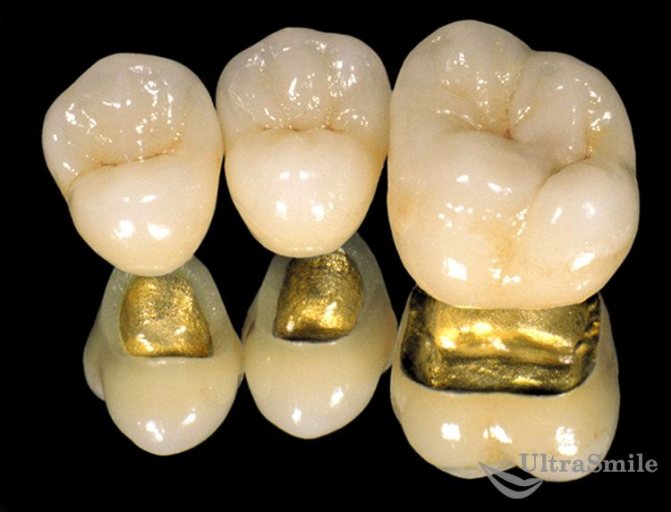
Gold tooth crown covered with ceramics
Metal and metal-ceramic structures (with ceramic lining) are created from gold - single dental crowns, bridges, fixed structures for fixation on implants.
Caring for gold crowns is not difficult. As for aesthetics, each patient has the right to decide for himself whether gold crowns will decorate his smile, or whether it is worth using more classical prosthetic methods.
Video review of a patient a year after dental implantation in 3 days at the Smile-at-Once clinic. Implantation in 3 days – it’s real!
Notice
: Undefined variable: post_id in
/home/c/ch75405/public_html/wp-content/themes/UltraSmile/single-item.php
on line
45 Notice
: Undefined variable: full in
/home/c/ch75405/public_html/wp-content /themes/UltraSmile/single-item.php
on line
46
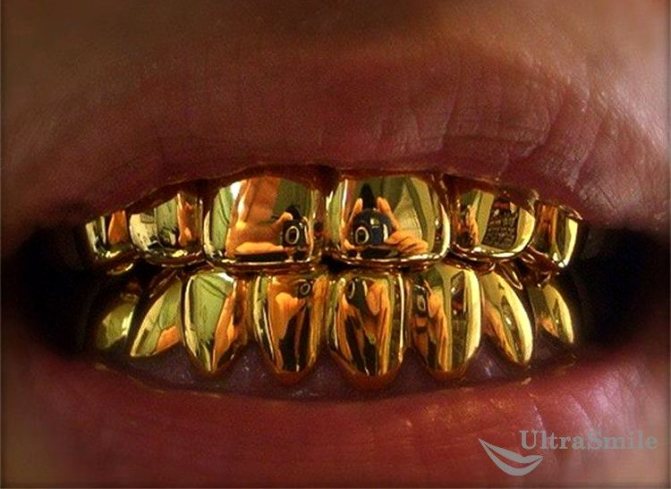
Rate this article:
crown
Consulting specialist
Sambuev Bair Sergeevich
Specialization: Orthopedic dentist Experience: 10 years
Indications and contraindications
There are both indications and contraindications for the installation of such dental products. First of all, these are situations where it is possible to install only gold prostheses. Such cases include:
- the need to strengthen teeth;
- improving the aesthetic appearance of the row;
- restoration of teeth actively involved in the chewing process;
- the need to restore the previous shape of the tooth;
- Having a strong bite or teeth grinding habit.
There are a number of contraindications for installing gold crowns. It is not recommended to install them:
- under the age of 16;
- for diseases associated with the psyche;
- during pregnancy;
- with periodontitis.
If you are thinking about installing gold crowns to decorate your teeth, then stop. There is an easier way to decorate your teeth - grills:
Gold crowns

In the past, gold crowns were the most popular way to restore lost teeth. This was completely justified, because gold is one of the safest materials for the body. In addition, gold lends itself well to processing. Fortunately, now gold crowns are becoming a thing of the past, as more suitable materials for prosthetics have appeared. The main disadvantage of gold crowns is their appearance. They are completely different from natural teeth, so they have been replaced by other technologies. In the modern world, the aesthetic factor plays, if not the main, then one of the main roles when restoring dentition. Therefore, gold crowns are becoming a thing of the past.
They can usually be found in older people who had dentures installed many years ago. Judging by the appearance of the crowns, we can conclude that their service life is almost unlimited. In addition to durability, gold crowns have a number of advantages, such as compatibility with the human body, the absence of allergic reactions and irritation. In addition, gold is a fairly soft material, which ensures a tight fit to the dental tissues. As a result, bacteria do not get under the crown, which has a beneficial effect on the condition of the oral cavity. Be that as it may, gold and other metal crowns do not at all meet modern aesthetic requirements for the appearance of teeth. Therefore, they can hardly be recommended for installation on the front teeth. It is better to use ceramic or metal-ceramic crowns. But gold crowns can be used as a replacement for lateral chewing teeth.
The price includes all manipulations for manufacturing, installation and fitting, including taking impressions. Treatment is guaranteed for up to 3 years!
Sign up for a consultation
Indications for prosthetics with gold crowns
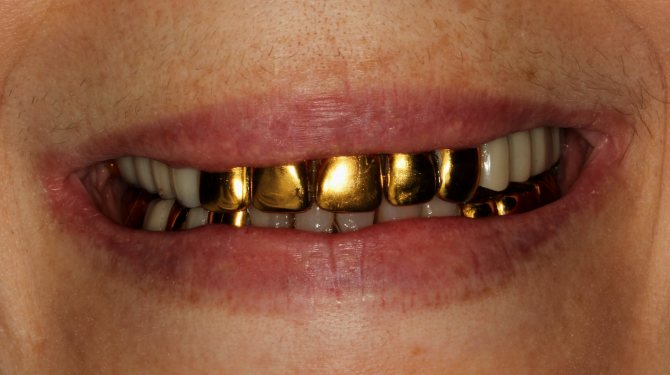
There are few individual indications for the installation of gold crowns. The main one is the factor of pathological abrasion of tooth enamel. To prevent abrasion, it is important to fix the height of the tooth, that is, the level where they meet each other. In this case, it is recommended to install crowns made of metals, in particular gold. At the same time, gold crowns are really one of the best options, since they take root well in the body. In other cases, it is recommended to install more modern ceramic or metal-ceramic prostheses. They are practically indistinguishable from natural teeth, do not cause injury to the gums and neighboring teeth, are durable and comfortable to wear. The use of gold crowns is not justified due to the high cost of the alloy, the rigidity of the material and the unpresentable appearance.
Another indication for the installation of gold crowns, which may seem strange and unusual, is the desire of the patient himself. Indeed, gold crowns and gold jewelry on teeth have recently become popular and fashionable. Some Hollywood stars wear gold linings and mouthguards encrusted with precious stones. Therefore, it is not surprising that other people also wanted to wear such unusual jewelry in their mouths.
Types of gold crowns

Gold crowns are not made entirely of gold because the metal is too soft. To strengthen the crowns, platinum and palladium are added to them. In order to give a more aesthetic appearance, dental crowns are covered with a layer of ceramic. Often the ceramic layer is applied only on the outside, which can lead to chipping. A more reliable way is to create metal-ceramic prostheses on gold, coated on all sides with a layer of ceramics. However, this is a completely different prosthetic technology that requires a separate discussion.
There are several types of gold crowns:
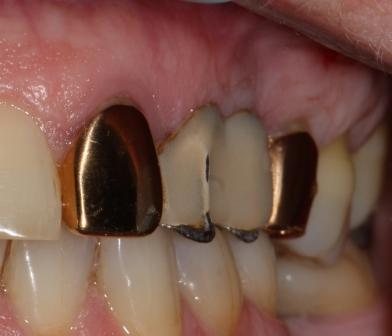
stamped: this technology is already outdated. It was popular at a time when there was no access to other prosthetic technologies in domestic dentistry. Stamped crowns are made from sleeves or metal plates made of gold alloy. The technology of prosthetics comes down to the following: the dentist takes an impression of the jaw, on the basis of which a plaster model of the tooth is created. The plaster model serves as a template for shaping the gold sleeve into the shape of a tooth. After this, the dental technician finalizes the crown, which will be installed in the patient’s mouth. This method has a number of significant disadvantages: the crown does not adhere tightly to the tissues, so food debris gets clogged under it, and plaque forms. The cement used to fix the prosthesis begins to dissolve after some time, which is a consequence of the formation of caries. The ends of the crown can damage the gums.
solid: high-precision monolithic casting technology is used here. Unlike the stamping method, such crowns follow the shape of the tooth and therefore do not injure the gums. In addition, due to the smoothness of the denture, plaque formation is reduced. Solid gold crowns are more durable than stamped ones, however, it is necessary to carry out a tooth preparation procedure before installing the prosthesis in the oral cavity.
Prosthetic technology

First of all, the oral cavity is prepared for prosthetics. The abutment tooth is turned and the nerve is removed. A gold prosthesis will be fixed to the supporting tooth. A dental crown is then created in the laboratory based on the impression and plaster model. The manufactured prosthesis is securely fixed on the abutment tooth, previously prepared for installation.
Advantages of gold crowns:
- protection against bacteria: gold alloys prevent the accumulation of dangerous bacteria under the crown. However, there is no substitute for good oral hygiene. You should not count on the fact that simply installing gold crowns will prevent the development of dental diseases;
- do not cause allergic reactions due to the fact that gold does not emit oxides, which are a common cause of irritation and allergies;
- gold crowns are highly durable and have incredible durability; they can last for years without any signs of deformation or destruction;
- gold crowns are softer than other types of metals, which not only ensures wearing comfort, but also allows the prosthesis to fit tightly onto the supporting tooth.
Disadvantages of gold crowns:
- high price;
- unpresentable appearance.
Alternatives to dental crowns
An alternative to gold crowns can be any modern prosthetic technology. For example, prostheses made of zirconium dioxide or metal ceramics. They are durable, reliable and attractive. Unlike gold crowns, they are almost impossible to distinguish from real teeth. Still, the main disadvantage of gold crowns is their unaesthetic appearance. Today there are not many people who want to install gold prostheses. Naturalness and naturalness are much more popular. Modern aesthetic dentistry offers many technologies that allow you to restore lost teeth. At the same time, dentures will provide comfort to wear and relieve psychological discomfort.
At the same time, today there is a really large selection of methods for restoring teeth. Visit a dentist for a consultation and he will definitely select the preferred type of crowns, taking into account the individual characteristics of your body and your financial capabilities.
Tooth preparation and crown installation
Preparation and installation of prostheses requires certain stages. For this process you need:
- Prepare the tooth. If caries is present, carry out special treatment and replace the filling.
- Before the procedure itself, the tooth should be numbed.
- The tooth is ground down on each side and adjusted to the thickness of the crown. It is given the required shape. Be sure to leave small ledges to secure the crown.
- The next step is taking impressions of the upper and lower dentition.
- A wax model is made using a plaster cast.
- The gold prototype is cast.
The patient is given a temporary crown, which remains in place until the gold one is made, since this process takes a certain time. It will protect the tooth from damage and destruction. After making a permanent crown, it is installed as follows:
- First, it is tried on and, if necessary, adjusted to the tooth.
- Before fixing it, check how tightly it fits and whether the teeth and the crown fit together correctly.
- The last stage is fixation with special dental cement.
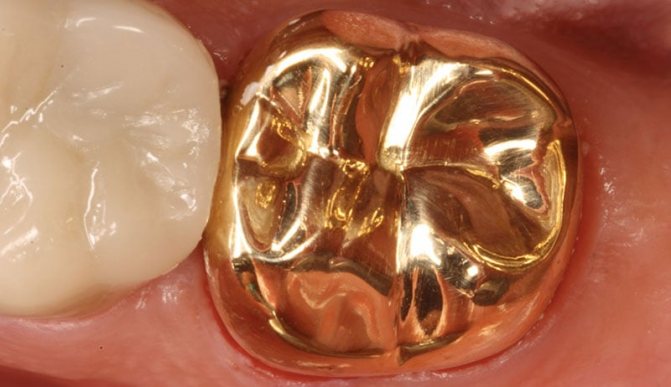
Manufacturing
Depending on the casting method, there are monolithic gold crowns :
- Stamped . They are made from existing blanks called sleeves. Their shape is modeled already in the oral cavity even before they are fixed with dental cement.
- Cast . Made from individual wax models. No adjustments are required directly in the mouth, as they are precisely modeled thanks to the impression taken.
This is interesting: Proper care of dental implants after installation
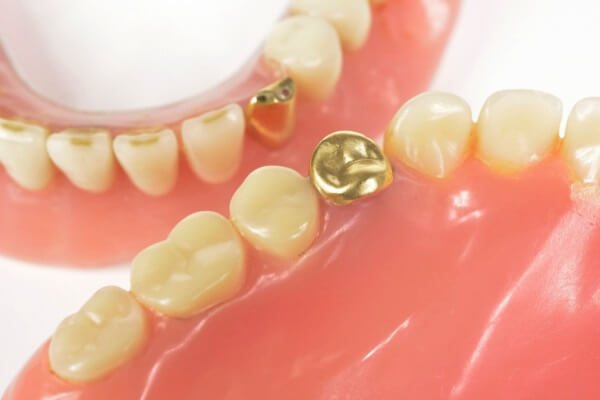
process occurs in several stages :
- After preparing the oral cavity, the orthopedist makes impressions of both jaws.
- Based on these impressions, plaster models are made , with the help of which an exact wax copy of the future crown will be made.
- An orthopedic dentist tries on a wax cast for a patient .
- Based on the impression, a gold crown is cast , which must be polished and installed in the oral cavity.
When making crowns, gold is used that is different from that used in the production of jewelry; the material for prosthetics is a special gold-containing alloy.
In addition to monolithic gold crowns, metal-ceramic prosthetics are widely used. Porcelain is used as a ceramic component, which hides the gold base. They are recommended to be placed on the visible part of the dentition.
Stamped
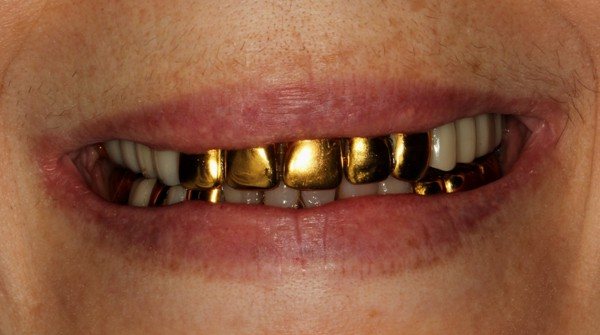
To make gold crowns using the stamping method, standard blanks are used. These can be thin plates made of a precious metal alloy or special sleeves.
The manufacturing process consists of the following stages:
- The dentist takes a photograph of the jaw row, on the basis of which a plaster model is made in the laboratory.
- Using a special apparatus, the prepared sleeve is processed to acquire the shape of a manufactured molar model.
- After final processing by the technician, the resulting gold alloy crown is handed over to the dentist for installation on the patient.
Making crowns using the stamping method has a significant drawback - the resulting product does not adhere tightly to the tissues of a person’s own tooth.
This leads to the accumulation of small food particles under the installed denture. In addition, installation of the structure requires a large amount of cement for fixation, which, if absorbed, can cause the development of caries.
Solid cast
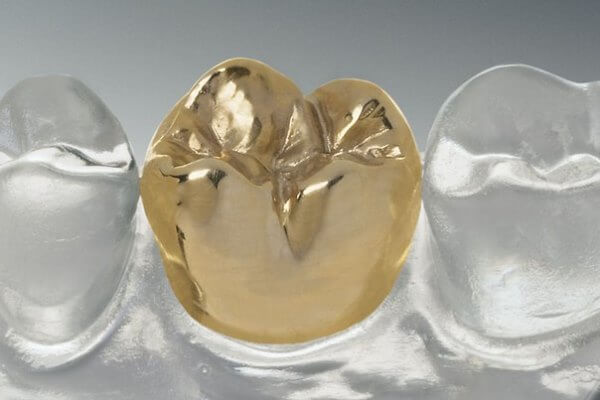
Solid gold structures are made using high-precision monolithic casting. For this purpose, special injection molding equipment is used.
Based on a dental impression of the molar, a collapsible plaster model is made. After this, a wax crown is formed, which will later be replaced with metal and processed according to dental requirements.
The advantages of solid crowns include their compliance with the anatomical shape of the tooth, the absence of traumatic effects on the gums and the reduction in the possibility of plaque accumulation due to the smooth surface.
A significant drawback of such products is the need to grind down their own organ to install the structure.
Manufacturing nuances
All-gold dental crowns can be created in two ways: stamping and casting. The first ones are made from special blanks (sleeves) and the shape and size are adjusted in the patient’s oral cavity depending on individual characteristics.
Cast ones are created strictly from a cast. They are considered to be very accurate, have a perfect fit, so installation takes minimal time.
In general, the manufacturing procedure looks like this:
- The dentist examines the oral cavity and prepares the tooth.
- To reduce discomfort, the patient is given an anesthetic for the period of tooth treatment.
- The bone formation is being turned, on which it is planned to install a gold crown. During the procedure, not only does the size of the tooth decrease, but its shape also improves.
- Impressions are taken of the upper and lower jaws. This is necessary in order to make the design as accurate as possible.
- In the laboratory, a plaster model of the jaw is created, through which a wax copy is reproduced.
- The patient tries on the finished cast.
- A crown is created.
The gold used in designs is different from that used in jewelry. A gold-containing composition is used here. It is thanks to him that it is possible to endow the crown with the required performance properties.
Advantages and disadvantages
Gold dentures have their pros and cons. Before deciding to install a gold crown on a tooth, you should study their advantages and disadvantages. The positive points include:
- beneficial effect of precious metal on teeth and microflora in the oral cavity;
- inertness of the metal in relation to the components of saliva and food;
- completely hypoallergenic;
- their ability to withstand any chewing load;
- quite a long lifespan, the durability of gold crowns with proper care can be extended to almost 15 years;
- protecting the tooth from caries, as gold has anti-inflammatory properties;
- inability to cause a destructive effect on the teeth in the opposite row at the junction of the jaws.
In the first days of installation, patients usually feel discomfort, which is not a disadvantage of the procedure. After a short period of time this condition will pass. The disadvantages of gold-plated teeth are:
- the softness of gold and gradual abrasion over time;
- very expensive installation, because gold itself is a precious metal;
- unaesthetic appearance of the front teeth.
A tooth with a crown and a living nerve becomes sensitive and reacts painfully to hot or cold food or drink, but this is a temporary phenomenon.
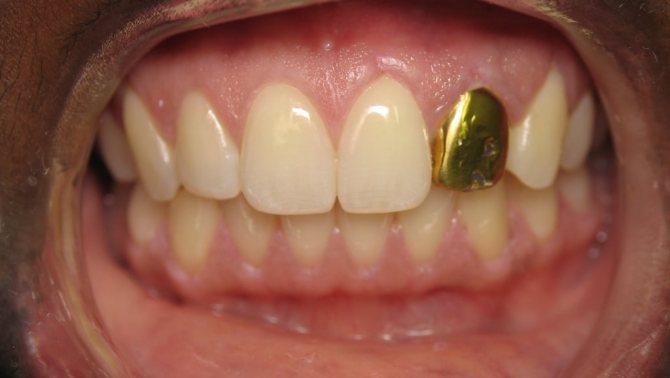
Such crowns are reused if they are in good condition, and they can also be sold or melted down.
How to care? How long will such a tooth last?
With proper care, such crowns will last a very long time - up to 15 years. For some people, gold teeth last 20 or 30 years and look great. To keep them in excellent shape, no special effort is needed. You just need to clean them twice a day as usual. You can rinse with antibacterial solutions or plain water. Visit your dentist's office every six months to evaluate the condition of your dentures. Dental gold dentures are the best and long-lasting solution for your teeth that do not require extensive maintenance.
Patient reviews
And I like gold teeth. This has always been considered an indicator of financial importance. I still have dentures from my grandmother; I can take them to a pawnshop. You just need to find out how to clean gold crowns from your teeth and check what kind of gold dental crowns are made of. But I wouldn’t put one on myself, because it’s unfashionable now.
Sergey, St. Petersburg
I am against gold teeth. They look unnatural. But last year I knocked out my front tooth during training. I went to the dental clinic and, as it turned out, not all dentures suit me. The dentist recommended inserting a gold tooth. I doubted it very much, but there were no other options for me. It turns out that they are placed for medical reasons. Especially if there are problems with the kidneys or liver.
In addition, gold dentures last about 15 years. You just need to take proper care of them. I asked what type of dental crowns are used. The doctor explained that gold teeth are of high standard and joked that this is a good investment.
Maxim, Nizhny Novgorod
Several years ago, on the recommendation of a doctor, I had gold teeth installed. It’s good that they are not front, so they don’t interfere with the aesthetics of the look. Gold interacts well with gums and does not cause discoloration. I didn't have any allergic reaction. I know that such teeth do not cause any negative reaction in the body. They are placed if the patient has significant stomach problems. Coated teeth often cause various complications.
However, I think that from time to time it is necessary to take pictures to make sure that everything is in order with the teeth.
It's just for insurance. And so they will serve for at least 10 years, or even more. Marina, Orel
Installation
To place a crown, you will need several steps, the number of which may vary slightly depending on where you receive the service:
- At the first appointment, an examination of the oral cavity . If this is necessary, the patient is sent to a dentist for oral sanitation.
- An orthopedic dentist grinds the prosthetic tooth , removing dense dental tissue 1.5 mm thick, which is almost half as much as when installing metal-ceramics.
- Impressions are made from plaster, after which a temporary plastic prosthesis is applied to protect the tissue and reduce its sensitivity. The temporary prosthesis also serves an aesthetic function.
- At the third appointment, the doctor puts on a crown , makes sure that it fits perfectly, does not interfere with the bite and tightly covers the tooth, then secures it with dental cement.
- After 3 months, the patient must visit the dentist again to have the crown removed.
The doctor will clean it of cement residues and check the condition of the soft tissues in the oral cavity. If no changes occur on the gums, the prosthesis is finally fixed to the composite material .
This is interesting: Which denture is better to put in the absence of a large number of teeth
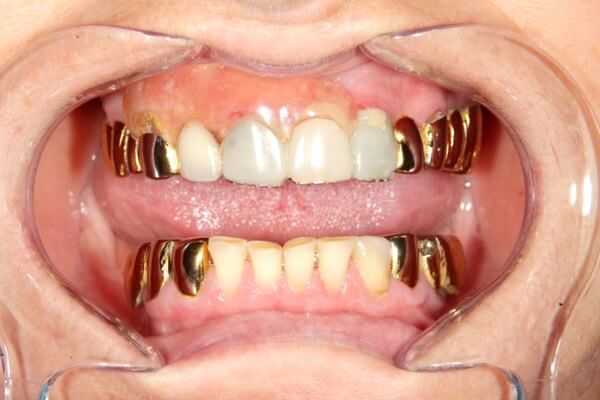
Photo: gold crowns on teeth
Preparation
Preparation is a multi-step procedure, during which you have to visit the doctor several times. It is necessary to follow all instructions to avoid complications.
The process of preparing the manufacture of a prosthesis consists of the following stages:
- The first stage involves preparation. It is advisable to carry out treatment if there are deviations.
- Before the procedure, everything must be thoroughly numbed; local anesthesia is most often used.
- We also have to trim off all the excess. All sides are ground and adjusted to the thickness of the crown being installed.
- Next, plaster casts are made. Using the plaster version, a wax model is made, then a gold prototype is cast.
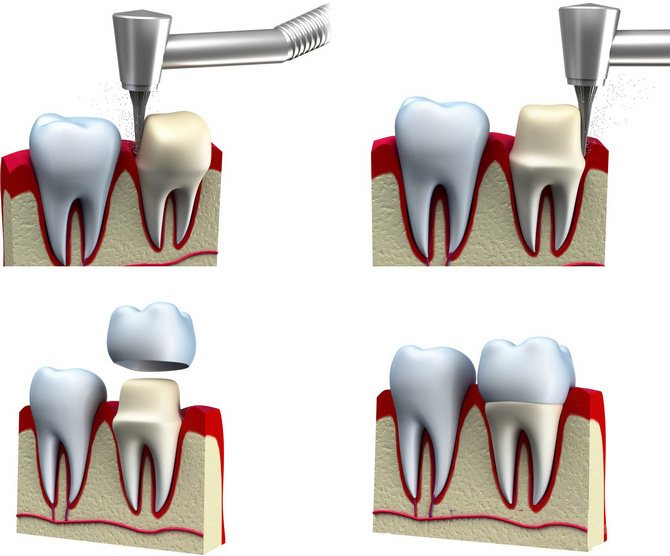
Installation
The permanent prosthesis is installed in the following way:
- The crown is being tried on. If there are deviations, additional adjustments are made.
- Before fixing, check how tightly it fits.
- Then they are fixed with special dental cement.
addictive
After prosthetics, you do not need to change your usual lifestyle. If your doctor allows, you can eat right away. In the first month, it is better not to eat solid foods that can damage the soft tissues of the oral cavity.
The patient after prosthetics is sometimes bothered by the following problems :
- Increased tooth sensitivity and slight discomfort. This usually occurs after the anesthesia wears off.
If depulpation was performed during prosthetics, the patient may feel discomfort when cold or hot drinks and foods enter the oral cavity.In this case, you will need a special toothpaste recommended by your dentist to care for your oral cavity.
- pain occurs , the prosthesis must be adjusted.
- In rare cases, parafunction of the masticatory muscles . In this situation, the doctor installs a night guard.
- The appearance of a cement taste in the mouth indicates its leaching from under the crown. It is necessary to consult a doctor to avoid infection and the development of caries.
Care
Special oral care is not required with gold crowns installed.
You need to brush your teeth twice a day with regular paste and rinse your mouth with special antibacterial solutions and visit the dentist every six months for professional oral hygiene.
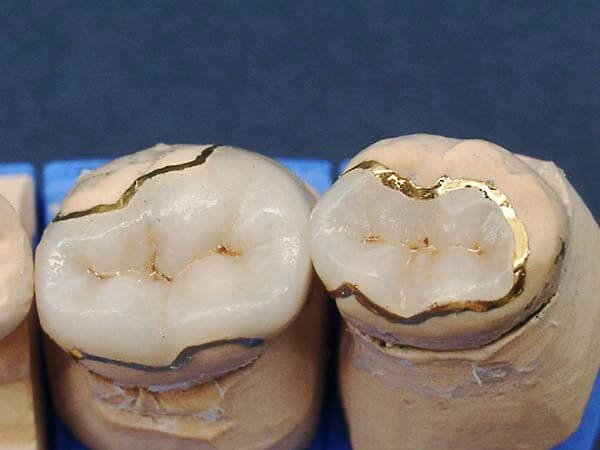
Rehabilitation period
If the work is performed at the proper level, there will be no need for special adaptation to gold microprostheses, since from the point of view of sensations they do not stand out in the dentition and are almost immediately able to withstand a full chewing load.
You will have to refrain from eating and drinking for several hours after installation. This need is determined by the materials used to secure the prosthesis.
In order to increase the service life and comfortable adaptation to the crown, it is not recommended to eat solid food.
Possible unpleasant consequences of installing crowns:
- Increased tooth sensitivity . Failure to remove the nerve under the treated tooth in advance increases the risk of a reaction to cold, hot, sour, etc. It is necessary for the dentist to prescribe a special toothpaste.

- A crown that is too high can cause pain when chewing . In such a situation, a second visit to the dentist will be required.
- When performing parafunction of the masticatory muscles on a patient, you will need to use a night guard.
- Washing out the cement on which the microprosthesis was fixed . This increases the risk of crown mobility, or its complete destruction, and infections penetrating under the structure. A second visit to a specialist is required to secure the crown more firmly.
FAQ
Many patients do not know which type of dental crown is best for them. A specialist will help you figure this out. When choosing the type of crown, the wishes of the patient, the condition of the oral cavity and the teeth on which the structures will be installed are taken into account. Indications and contraindications for a particular type of dental crown are taken into account, as well as the patient’s financial capabilities.
Questions most often asked by patients:
- Question: What types of dental crowns can contain gold?
Answer: Currently, in addition to a monolithic gold crown, metal-ceramic crowns are used, the frame of which can be made of gold.
- Question: What dentures are made using gold?
Answer: Metal and metal-ceramic. Fixed dental structures - implants - the crown is made of gold, and the implant is made of titanium. Bridges and crowns are also made from gold.
- Question: I want to get gold dental crowns. What standard of gold is required to make them?
Answer: 900 gold is used to make dentures.










